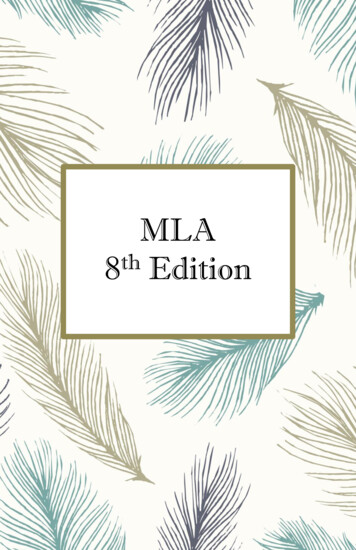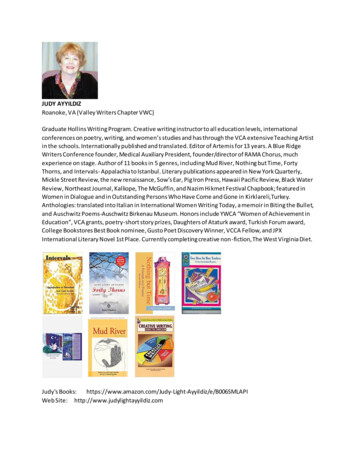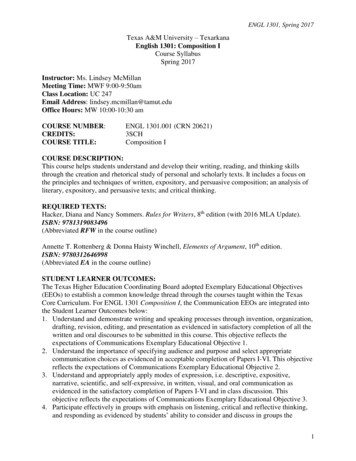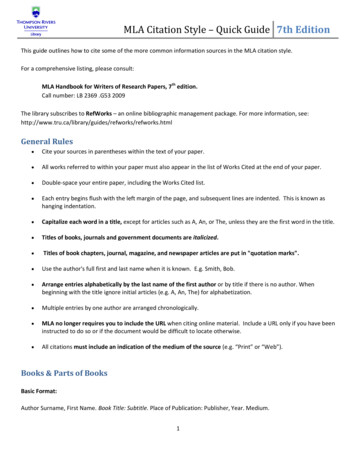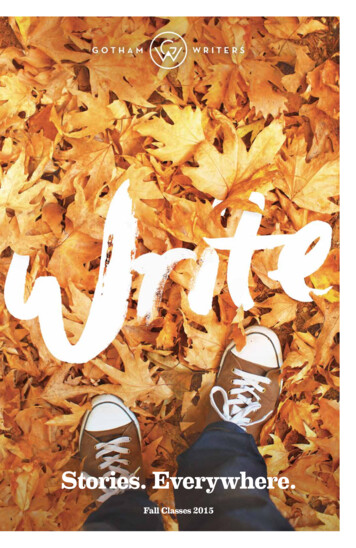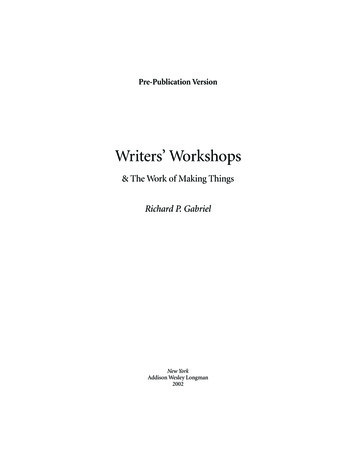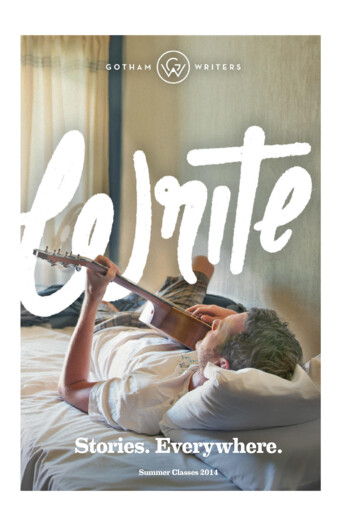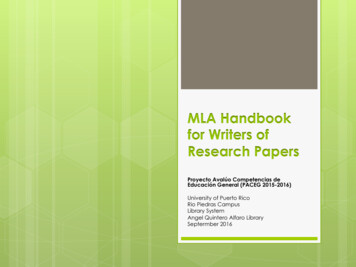
Transcription
MLA Handbookfor Writers ofResearch PapersProyecto Avalúo Competencias deEducación General (PACEG 2015-2016)University of Puerto RicoRio Piedras CampusLibrary SystemAngel Quintero Alfaro LibrarySeptermber 2016
Modern Language Association (MLA)Handbook for Writers of Research Papersu Thispresentation’s objectives are to: discuss showgeneral aspects of the MLA handbook,appropriate ways to cite, explainbasic rules and provide examples from aworks cited list.
Style Manualsu Style manuals are a set of guidelines for the compositionand presentation of written works.u They help: avoid plagiarism document the work (citation and works cited list)standardize the paper (font, spacing, abbreviations,footnotes, among others) u MLA is the handbook most frequently used to format writtenworks, citations and works cited lists in the humanities (art,literature, among others).
PlagiarismAccording to the American Heritage Dictionary of EnglishLanguage (2006) plagiarism in the context of a writtenwork is defined as “to use and pass off (the ideas orwriting of another) as one’s own.”u One plagiarizes when he/she:v copies another person’s words or ideas on purposewithout giving credit to the authors and passes itas if it is theirs.v buys, steals, or borrows someone’s written workand passes it as if it is theirs.v pays someone to write the work and passes it as ifit is theirs.
MLA Handbooku It is a guide that standardizes written worksin terms of: format, abbreviations, citationsnotes, and footnotes,and works cited lists, preparingpapers for publication.
General Text Formatu Print on 8.5x11 paper with one-inch margins at the top,bottom, left and right. Your last name and the paper’spage number are placed in the upper-right corner at halfan inch of each page of the document.u Do not justify the text: align left.u Indent the first line of each paragraph half an inch.u Leave one space after each period.u Use legible fonts, such as Times New Roman size 12.
General Text Formatu The title is centralized: do not underline or use italics, bold orquotation marks. Do not place a period at the end of the title.u Double-space the whole document including citations, notes,and the works cited list.
MLA: Basic FormatFirst Pageu Do NOT use a cover page unless theprofessor specifically requests it.u Begin writing on the top left corner ofthe first page: your name, followed bythe professor’s name, the coursenumber or title, and the date (see theexample to the right). Double-spacethis information.u Next, write and centralize the title ofyour paper immediately after.u Begin writing your paper in the nextline. Indent the first line of the text inthis and all subsequent paragraphs.Double-space the entire document.u Note that on the upper-right corner ofthe page, separated a half inch fromthe margin, the header includes yourlast name, a space, and the pagenumber of the paper.
A citation isu The of use someone else’s ideas or exact words toeither strengthen our argument or to document ourwork.
When quoting:u Weneed to indicate where we obtainedthis information from so as not toplagiarize.u In-text citations should clearly lead thereader to a specific source in the workscited list.
MLA: Types of Quotationsu The MLA style handbook presents two ways of quoting: thedirect quote and the paraphrase.v A direct quote is when you reproduce a text word by word.This type of quotation is enclosed within quotation marks.v Paraphrasing refers to writing an author’s ideas in your ownwords. Even when you express them in your own words, theideas still belong to the original author; therefore, you mustgive credit to the author. This type of quote is inserted in thetext without quotation marks, but it still requires parentheticalcitation to give credit to the original author.v The types of quotes that the MLA style handbook presentsare discussed in the following slides. The most importantelements in each citation are presented in red.
MLA: Types of Citationsu Example1: Direct QuoteWordsworth stated that Romantic poetry was marked by a"spontaneous overflow of powerful feelings" (263).In a direct quote, the text is enclosed within quotation marks.Citation includes the last name of the author, and the pagenumber where the text can be found.In this example, the last name of the author is included in thesentence; therefore, only the page number goes inside theparenthesis at the end.
MLA: Types of Citationsu Example 2: Direct QuoteRomantic poetry is characterized by the "spontaneous overflow ofpowerful feelings" (Wordsworth 263).In this example of a direct quote, the quotation marks enclose thequotation and the parenthetical citation includes the author’s lastname and the page number where the excerpt is found followed by aperiod.If the sentence of the original source begins with a quote, the firstletter of the sentence begins with a capital letter. If the sentence ofthe original source does not begin with a quote or it is a phrase, thefirst letter of the citation begins with a lower case letter.
MLA: Types of Citationu Example 3: Direct QuoteAccording to an expert on the topic, “it is commonlyassumed that violence is part of our frontier heritage.But the historical record shows that frontier violence wasvery different from violence today” (McGrath 17).In this example, the author’s last name and the pagenumber are placed within parenthesis at the end of thequote. MLA emphasizes that this type of citation shouldbe introduced with a signal phrase that highlights thebeginning of the quote. In this case the signal phrase is“according to an expert on the topic.”
MLA: Types of Citationu Example4: Direct Quote (Block quotation)If a direct quote is longer than 4 lines of text, weplace it as an independent block ½ inch fromthe main margin. Punctuation is different for thistype of citation: the parenthesis with thebibliographic information is placed after theperiod. The example is in the next slide.
MLA: Types of Citationu Example: Direct Quote (Block quotation: more than 4lines in length)As Bocij points out there are many ways in whichcriminals use the Internet to defraud or damage others:At one level a seller might misrepresent an itemin an online auction in order to cheat a buyer outof a few extra dollars. At another, a carefullymanaged stock fraud can damage an industry,resulting in losses that can be measured inbillions of dollars. (109)
MLA: Paraphraseu According to MLA, plagiarism sometimes occurswhen we fail to give credit to the original authorwhen: quoting directly or paraphrasing, using aword or phrase coined by another author andparaphrasing an argument or train of thought.u Remember that paraphrase is to present theauthor’s ideas in your own words; it is not enoughto replace some of the author’s words withsynonyms and call it a paraphrase.
MLA: Types of Citationsu Example: ParaphraseThe combination of new technologies and the ever-changingfield of information sciences offers a wide variety ofpossibilities when we set out to find the necessary information(Fidishun 328).This example presents a citation in which we paraphrase orwrite the author’s idea in our own words. However, because itis not our original idea, we must give credit to the author byincluding his or her last name and the page number where theexcerpt can be found within a parenthesis.
MLA: Authorship in Citationsu In many cases, the author of the source is not a person, but acorporation, an association, a university, or other. In these cases, theinformation related to the authorship is provided where an author’sname would usually appear.v If the author is a corporation, a university or another type of institution,the name of the entity is used in the citation. The name can be placedwithin parenthesis at the end of the citation or it can be mentioned in thesignal phrase that introduces it.Example: University of Puerto Rico (57)v If the source does not have an author, the parenthetical citation shouldinclude the title of the source. For example:We see so many global warming hotspots in North America likely because this regionhas "more readily accessible climatic data and more comprehensive programs tomonitor and study environmental change . . ." ("Impact of Global Warming" 6).
MLA: Authorship in Citationsu Whenthe extract to be cited is part of ananthology, the authorship belongs to theauthor of the section of the anthology, not tothe editor.
MLA: Authorship in CitationsIf the source has two authors, place both authors’last names in the signal phrase to introduce thequote or at the end of the quote in parenthesis,following the format of the previous examples:Chomsky and Herman argue that “a propagandamodel focuses on this inequality of wealth andpower and its multilevel effects on mass-mediainterests and choices” (2).u u If the source has 3 authors or more, introduce onlythe first author’s last name followed by the phraseet al. The phrase that introduces the quote shouldbe plural.Example: According to Stinson, et al,
MLA: Citations for Non-Print orOnline Sourcesu Include the information on the works cited list in thefollowing order: author, title, name of website or title ofmovie.u Page numbers are not required.u Write only the title of the web page, not the complete onlineaddress on the document.u Whenever the title is the same as the online address, writeonly part of it. Example: cnn.com NOT http://www.cnn.com
MLA: General Informationu According to MLA general information does not have tobe cited. However, you should assess the presentationor paper’s audience and consider if that informationwould be general to them. Therefore, it is essential thatyou know the audience or reader you are addressing.u Examples of general information are:v v v Dates of important historical events (ChristopherColumbus arrived in America in 1492)Biographic facts about famous historical figures(George Washington was the first president of theUnited States)Geographic facts (The United States is part of theAmerican continent)
Strategies to Avoid Plagiarismu According to MLA, you can avoid plagiarism by:v v v v Making a list of all the authors and points of viewreferenced so you can check them off as you writeyour paper and cite them.Keeping a clear track of your ideas, separate from asummary of other authors’ ideas, and the directquotations you plan to include.Identifying all the necessary elements to cite all thesources you use as direct quotations, paraphrase,arguments and facts.Speaking with your professor or librarian when you arenot sure about the proper use of a source.
MLA: Works Citedu Begin the works cited list on a separate page at the end of thepaper.u Write Works Cited as the title of the page, centralized at the verytop. Do not write the title in bold, italics or underline the words. Donot use quotation marks.u All entries should be double-spaced, as well as the rest of thedocument.u Do not indent the first line of each entry. Instead, indent thesecond line and the ones that follow.u For online sources, you should include the URL address.u When the document is written in English, the first letter of eachword in the title of a source is capitalized, except for prepositionsand articles.
MLA: Works CitedContrary to previous editions, the 2016 MLA revisiondoes not require that we indicate the format of thesource (print, web) in the bibliographic entry.u In the case of journals, use the abbreviation vol. forvolume, no. for number, p. for page and pp. forseveral pages.u Periods are placed only after the author’s name andthe title. Use a comma after all other elements in theentry.u The city of publication, year of original publication andthe access date to the website are included in theentry only if it is necessary or relevant to the reader.u
MLA: Works Citedu Example of a book with one author:Hersey, John. Hiroshima. Vintage Books, 1989.u The author’s last name appears first, according to theinformation that the source provides, followed by the author’sfirst name. After the period, add the title of the source initalics, then a period, followed by the publisher and the dateof publication. Pay special attention to all punctuation marks.
MLA: Works Citedu If the source has two or more authors, they must bepresented in the same order in which they appear in thesource. Place the last name before the first name only for thefirst author mentioned (last name, first name); the names ofthe authors that follow go in their traditional form (first namelast name). For example:Baron, Robert, and John Smith.
MLA: Works Citedu If the source has more than three authors, the name of the firstauthor is the only one included, followed by the phrase et al(Latin for “and others”), or you may list all the authors in theorder in which they appear in the original work. For example:Plag, Ingo, et al. Introduction to English Linguistics. Mouton, 2007.orPlag, Ingo, Maria Braun, Sabine Lape, and Mareile Schramm.Introduction to English Linguistics. Mouton, 2007.
MLA: Examples of Works Citedu Academic Journal in Print FormatPiper, Andrew. “Rethinking the Print Object: Goethe and the Book of Everything.”PMLA, vol. 121, no.1, 2006,124-38.u In this example, the author’s last name and first name go first, followed by the titleof the article inside quotation marks. Then, we add the name of the journal initalics, the information related to the volume and issue, followed by the year ofpublication in parenthesis. Immediately after, write a colon, space, the pagenumbers where the article is located, and the medium of publication.u An academic journal is a periodical in which articles have been peer reviewed. Likeother periodicals, academic journals have volume and issue numbers. In the casepresented above, 121 is the volume and the 1 is the issue number.
MLA: Examples of Works Citedu Article from an Academic Journal Obtained from a DatabaseJaramillo, Carlos y Andrés Cárdenas. “Global Warming and NeotropicalRainforests: A Historical Perspective.” Annual Review of Earth and PlanetarySciences, vol. 41, 2013, pp. 9-16. Annual Reviews, doi: 10.1146/annurevearth-042711-105403. Accessed October 5th, 2016.u The entry on the works cited list for an article from anacademic journal that was obtained from a database ispresented in the same way an article from a printed academicjournal is presented. However after the page number, specifythe name of the data base in italics and the DOI number. In thecases that the DOI is not specified, write the URL. If needed,write the date the article was retrieved.
MLA: Examples of Works Citedu Magazine Article: Magazines like Times and National Geographic,among others, are usually intended for the general public, yet manyof them include information that can be used to document facts.u This type of source would appear in the Works Cited page as follows:McEvoy, Dermont. “Little Books, Big Success.” PublishersWeekly, 30 Oct. 2006, pp. 26-28.u The last name and first name of the article’s author appear firstseparated by a comma. Then write the title of the article insidequotation marks, followed by the title of the magazine in italics. Afterthat, add the date of publication and the page numbers. Be sure tocheck all punctuation.
MLA: Examples of Works Citedv If the magazine is published weekly or every two weeks, include thecomplete date: day, month abbreviation (except May, June and July)and the year. Then, write a comma and the page numbers of thearticle. For example:5 Nov. 2014, pp. 70-71.5 June 2014, pp. 15-18.v If the magazine is published monthly or every two months, includethe month or months and the year, followed by the page numbers.The volume and issue are not specified. For example:Kates, Robert W. “Population and Consumption: What We Know,What We Need to Know.” Environment, Apr. 2000, pp. 10-19.
MLA: Examples of Works Citedu Movies: The entry usually begins with the title in italics.Other elements that follow are the director’s name, theperformers’ names, the distributor, and the release year.For example:It’s a Wonderful Life. Directed by Frank Capra, performances by JamesStewart, Donna Reed, Lionel Barrymore, and Thomas Mitchel, RKO,1946.
MLA: Useful ttp://isites.harvard.edu/icb/icb.do?keyword k70847&pageid esource/747/01/
Works CitedThe Modern Language Association of America. MLAHandbook, 8th ed., MLA, 2016.“Plagiarism.” The American Heritage Dictionary of EnglishLanguage. American Heritage Publishing Company, 2006.The Purdue OWL Family of Sites. The Writing Lab and OWL atPurdue and Purdue U, 2008, owl.english.purdue.edu/owl.Accessed 29 Sep. 2016.
Handbook for Writers of Research Papers ! This presentation’s objectives are to: ! discuss general aspects of the MLA handbook, ! show appropriate ways to cite, ! explain basic rules and provide examples from a works cited list. Style Manuals ! Style manuals are a
